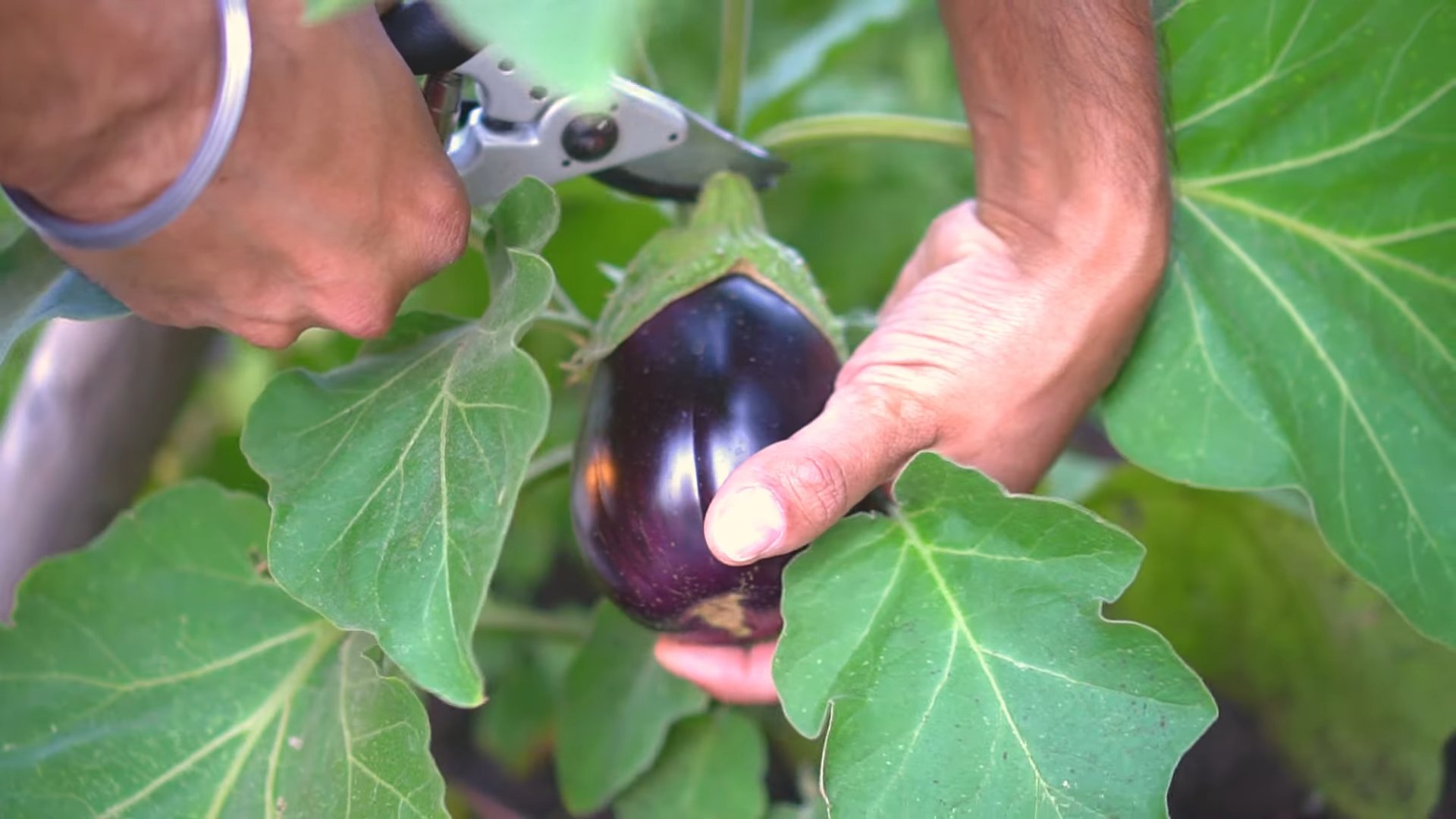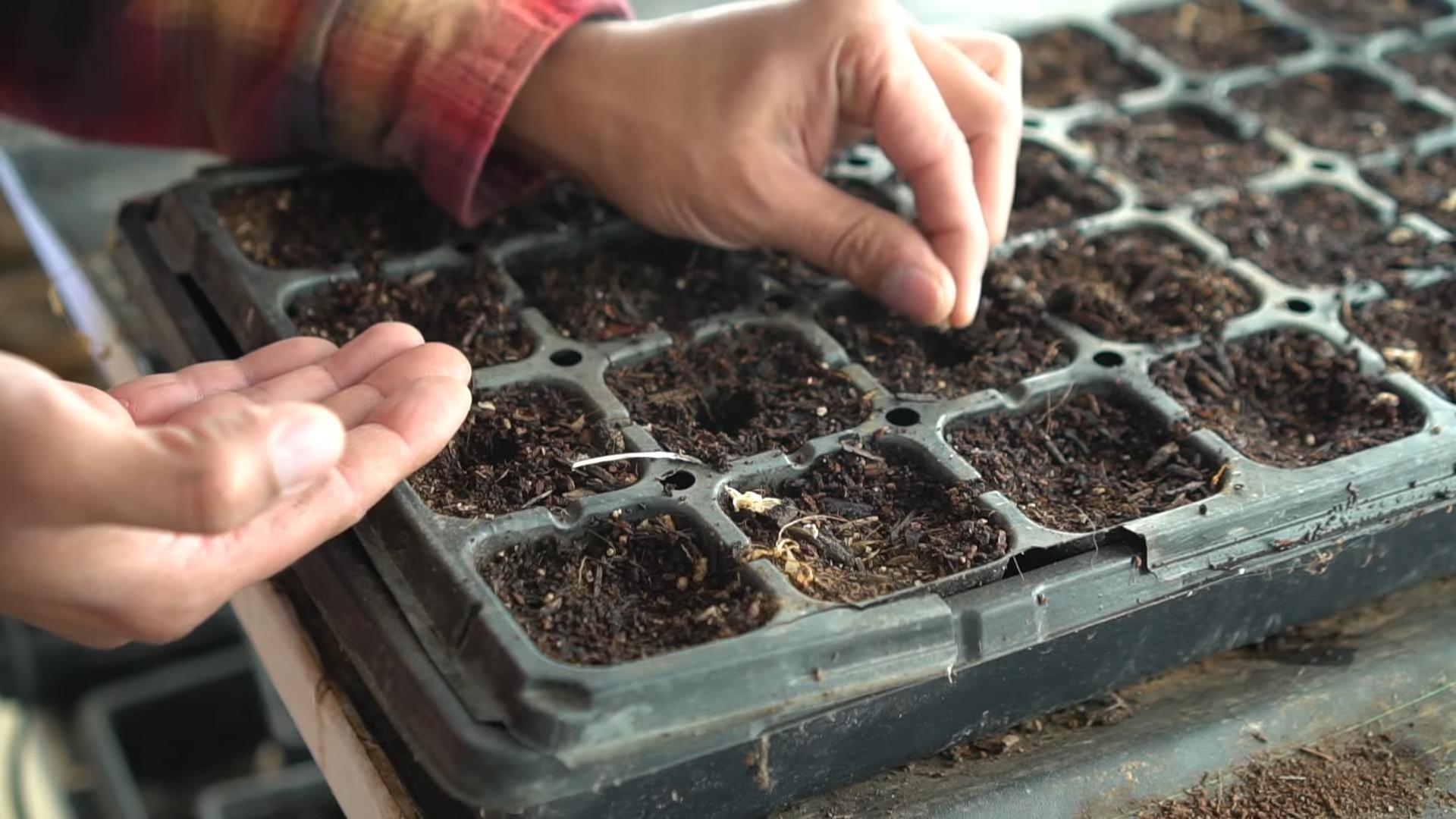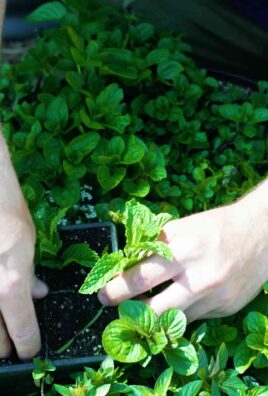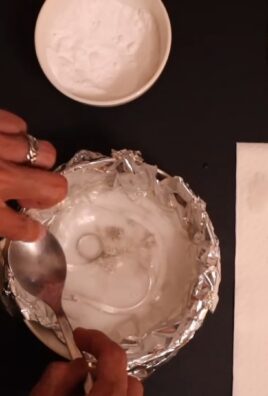Growing Eggplants Successfully can feel like a real victory in the home garden! I know, I know, sometimes they can be a bit finicky, but trust me, the reward of biting into a freshly harvested, sun-ripened eggplant is absolutely worth the effort. Have you ever wondered where these glossy, purple beauties originated? Eggplants have a rich history, tracing back to ancient India, where they were cultivated for thousands of years before making their way across the globe. They weren’t always the plump, purple vegetables we know today; some early varieties were small, white, and resembled eggs, hence the name!
But let’s be honest, who has the time (or the space!) for complicated gardening techniques? That’s where these DIY tricks and hacks come in. We’re all about making growing eggplants successfully easier and more accessible, even if you only have a small balcony or patio. I’m going to share some simple, yet effective, tips that will help you avoid common pitfalls like blossom-end rot, pest infestations, and stunted growth. Imagine serving up delicious eggplant parmesan or baba ghanoush made with eggplants you nurtured from seedling to harvest. It’s not just about the food; it’s about the satisfaction of connecting with nature and creating something amazing with your own two hands. So, grab your gardening gloves, and let’s get started!

Growing Eggplants: A Comprehensive DIY Guide for a Bountiful Harvest
Hey there, fellow gardening enthusiasts! I’m so excited to share my tried-and-true methods for growing plump, juicy eggplants right in your own backyard. Eggplants, with their glossy skin and unique flavor, can be a rewarding addition to any garden. While they can be a bit finicky, with the right knowledge and a little TLC, you’ll be harvesting a bumper crop in no time. Let’s dive in!
Choosing the Right Eggplant Variety
Before we even think about planting, it’s crucial to select the right eggplant variety for your climate and preferences. There’s a whole world of eggplants beyond the standard globe-shaped purple ones!
* Globe Eggplants: These are your classic, large, purple eggplants, perfect for eggplant parmesan or grilling. ‘Black Beauty’ is a popular and reliable choice.
* Asian Eggplants: These tend to be longer and thinner than globe eggplants, with a more delicate flavor and tender skin. ‘Ichiban’ and ‘Long Purple’ are excellent options.
* Italian Eggplants: These are smaller and more oval-shaped than globe eggplants, often with a slightly sweeter taste. ‘Rosa Bianca’ is a beautiful heirloom variety with lavender and white stripes.
* White Eggplants: These offer a mild, almost mushroom-like flavor. ‘Casper’ is a popular variety.
Consider your local climate and growing season when making your selection. Some varieties are more heat-tolerant than others, while some mature earlier, which is important if you have a short growing season.
Starting Eggplant Seeds Indoors
Eggplants need a long growing season, so starting them indoors is usually the best way to get a head start, especially if you live in a cooler climate. I usually start my seeds about 8-10 weeks before the last expected frost.
1. Gather Your Supplies: You’ll need seed starting trays or small pots, a seed starting mix (I prefer a mix of peat moss, vermiculite, and perlite), eggplant seeds, a spray bottle, and a heat mat (optional, but highly recommended).
2. Prepare the Seed Starting Mix: Moisten the seed starting mix with water until it’s damp but not soggy.
3. Sow the Seeds: Fill your seed starting trays or pots with the moistened mix. Sow the eggplant seeds about ¼ inch deep, placing 2-3 seeds per cell or pot.
4. Water Gently: Use a spray bottle to gently water the seeds. Avoid overwatering, as this can lead to damping off, a fungal disease that can kill seedlings.
5. Provide Warmth: Eggplant seeds need warmth to germinate. Place the seed starting trays on a heat mat set to around 80-85°F (27-29°C). If you don’t have a heat mat, you can place them in a warm location in your house.
6. Maintain Moisture: Cover the seed starting trays with a clear plastic dome or plastic wrap to help retain moisture. Check the soil daily and mist with water as needed to keep it moist.
7. Wait for Germination: Eggplant seeds typically germinate in 7-14 days. Once the seedlings emerge, remove the plastic dome or plastic wrap and move the trays to a sunny location or under grow lights.
8. Provide Light: Eggplant seedlings need at least 6-8 hours of direct sunlight per day. If you don’t have enough natural light, use grow lights. Place the lights a few inches above the seedlings and adjust as they grow.
9. Thin the Seedlings: Once the seedlings have their first true leaves (the second set of leaves), thin them to one seedling per cell or pot. Choose the strongest, healthiest seedling and snip off the others at the soil line.
10. Harden Off the Seedlings: Before transplanting the seedlings outdoors, you need to harden them off. This process gradually acclimates them to outdoor conditions. Start by placing the seedlings outdoors in a sheltered location for an hour or two each day, gradually increasing the amount of time they spend outdoors over the course of a week or two.
Preparing the Garden Bed
Eggplants thrive in warm, sunny locations with well-drained soil. Choose a spot in your garden that receives at least 6-8 hours of direct sunlight per day.
1. Choose a Sunny Location: As I mentioned, sunlight is key! Make sure your chosen spot gets plenty of it.
2. Prepare the Soil: Eggplants prefer well-drained soil that is rich in organic matter. Amend the soil with compost, aged manure, or other organic materials to improve drainage and fertility. I usually add a generous amount of compost to my garden bed before planting.
3. Check the Soil pH: Eggplants prefer a slightly acidic soil pH of 6.0-6.8. You can test your soil pH using a soil testing kit. If your soil is too alkaline, you can amend it with sulfur. If it’s too acidic, you can add lime.
4. Create Raised Beds (Optional): If your soil is poorly drained, consider creating raised beds. Raised beds improve drainage and allow the soil to warm up more quickly in the spring.
5. Add Fertilizer: Before planting, incorporate a balanced fertilizer into the soil. I like to use a slow-release organic fertilizer.
Transplanting Eggplant Seedlings Outdoors
Once the danger of frost has passed and the soil has warmed up, it’s time to transplant your eggplant seedlings outdoors.
1. Choose a Cloudy Day: Transplanting on a cloudy day will help reduce stress on the seedlings.
2. Dig Holes: Dig holes that are slightly larger than the root balls of the seedlings. Space the holes about 18-24 inches apart.
3. Remove Seedlings from Pots: Gently remove the seedlings from their pots, being careful not to damage the roots.
4. Plant the Seedlings: Place the seedlings in the holes and backfill with soil. Make sure the top of the root ball is level with the surrounding soil.
5. Water Thoroughly: Water the seedlings thoroughly after planting.
6. Mulch: Apply a layer of mulch around the plants to help retain moisture, suppress weeds, and regulate soil temperature. I like to use straw or shredded leaves.
7. Provide Support: Eggplant plants can get quite heavy with fruit, so it’s a good idea to provide them with support. You can use stakes, cages, or trellises. I prefer using tomato cages, as they provide good support and allow the plants to grow naturally.
Caring for Eggplant Plants
Once your eggplant plants are in the ground, it’s important to provide them with proper care to ensure a bountiful harvest.
* Watering: Eggplants need consistent watering, especially during hot, dry weather. Water deeply and regularly, aiming to keep the soil moist but not soggy. Avoid overhead watering, as this can promote fungal diseases.
* Fertilizing: Eggplants are heavy feeders, so they need regular fertilization. Fertilize every 2-3 weeks with a balanced fertilizer or a fertilizer specifically formulated for tomatoes and peppers.
* Weeding: Keep the garden bed free of weeds, as weeds can compete with eggplant plants for nutrients and water.
* Pest Control: Eggplants are susceptible to a variety of pests, including flea beetles, aphids, and spider mites. Inspect your plants regularly for signs of pests and take action promptly. I like to use organic pest control methods, such as insecticidal soap or neem oil.
* Pruning: Pruning can help improve air circulation and promote fruit production. Remove any suckers (small shoots that grow from the base of the plant) and any yellowing or diseased leaves.
* Pollination: Eggplants are self-pollinating, but they benefit from insect pollination. Encourage pollinators to visit your garden by planting flowers that attract bees and other beneficial insects.
Dealing with Common Eggplant Problems
Even with the best care, eggplant plants can sometimes encounter problems. Here are some common issues and how to address them:
* Flea Beetles: These tiny beetles can chew small holes in the leaves of eggplant plants. Cover young plants with row covers to protect them from flea beetles. You can also use insecticidal soap or neem oil to control them.
* Aphids: These small, sap-sucking insects can weaken eggplant plants. Spray aphids with a strong stream of water or use insecticidal soap.
* Spider Mites: These tiny mites can cause yellowing and stippling of the leaves. Spray spider mites with insecticidal soap or neem oil.
* Blossom-End Rot: This condition causes the bottom of the eggplant fruit to rot. Blossom-end rot is caused by a calcium deficiency. Ensure your soil has adequate calcium and water plants consistently.
* Verticillium Wilt: This fungal disease can cause wilting and yellowing of the leaves.

Conclusion
So, there you have it! Mastering the art of growing eggplants successfully doesn’t require a green thumb blessed by the gardening gods. It’s about understanding the plant’s needs, providing the right environment, and employing a few clever DIY tricks to boost its growth and protect it from common problems. This guide has armed you with the knowledge to tackle everything from seed starting to pest control, ensuring a bountiful harvest of delicious, glossy eggplants.
Why is this DIY approach a must-try? Because it empowers you to take control of your garden, reduce your reliance on potentially harmful chemicals, and ultimately, enjoy fresher, more flavorful eggplants. Imagine the satisfaction of serving a dish made with eggplants you nurtured from tiny seeds, knowing exactly what went into their growth. That’s a reward in itself!
But the journey doesn’t end here. Experiment with different varieties of eggplants to find your favorites. Try growing them in containers if you have limited space. Consider companion planting with herbs like basil or thyme to deter pests naturally. Explore different methods of staking or caging your plants to provide optimal support. The possibilities are endless!
Don’t be afraid to get your hands dirty and embrace the learning process. Gardening is a journey of discovery, and every season brings new challenges and opportunities. We encourage you to try these DIY tricks for growing eggplants successfully and witness the difference they can make.
And most importantly, share your experiences! Let us know what worked for you, what challenges you faced, and any other tips or tricks you discovered along the way. Your insights can help other gardeners achieve their eggplant-growing dreams. Post your photos, share your stories, and let’s build a community of passionate eggplant enthusiasts! Happy gardening!
Frequently Asked Questions (FAQs)
What are the most common problems when growing eggplants, and how can I prevent them?
Eggplants are susceptible to several common issues, but proactive measures can significantly reduce their impact. One frequent problem is blossom-end rot, characterized by a dark, sunken spot on the bottom of the fruit. This is usually caused by calcium deficiency due to inconsistent watering. To prevent it, ensure consistent watering, especially during hot, dry periods. Mulching around the plants helps retain moisture. You can also amend the soil with calcium-rich amendments like bone meal or crushed eggshells before planting.
Another common issue is pest infestations, particularly by flea beetles, aphids, and tomato hornworms. Regularly inspect your plants for signs of these pests. For flea beetles, consider using row covers early in the season to protect young plants. For aphids, a strong blast of water from a hose can dislodge them. For tomato hornworms, handpicking them off the plants is often the most effective solution. Introducing beneficial insects like ladybugs and lacewings can also help control aphid populations naturally.
Fungal diseases like Verticillium wilt and Fusarium wilt can also affect eggplants. Choose disease-resistant varieties whenever possible. Practice crop rotation to prevent the buildup of these pathogens in the soil. Ensure good air circulation around the plants by spacing them adequately and pruning any overcrowded foliage.
How often should I water my eggplants?
Watering frequency depends on several factors, including the weather, soil type, and the size of your plants. Generally, eggplants need consistent moisture, especially during fruit development. Aim to water deeply whenever the top inch of soil feels dry to the touch. This might mean watering every day or two during hot, dry weather, or less frequently during cooler, wetter periods.
Avoid overwatering, as this can lead to root rot. Use a soaker hose or drip irrigation to deliver water directly to the roots, minimizing water loss through evaporation and reducing the risk of fungal diseases. Mulching around the plants helps retain moisture and reduces the need for frequent watering.
What kind of fertilizer should I use for eggplants?
Eggplants are heavy feeders and benefit from regular fertilization. Start with a balanced fertilizer (e.g., 10-10-10) at planting time, following the package instructions. Once the plants begin to flower and set fruit, switch to a fertilizer higher in phosphorus and potassium (e.g., 5-10-10) to promote fruit development.
You can also supplement with organic fertilizers like compost tea or fish emulsion. These provide essential nutrients and beneficial microbes to the soil. Avoid over-fertilizing, as this can lead to excessive foliage growth at the expense of fruit production. Side-dress the plants with fertilizer every few weeks throughout the growing season.
How do I know when my eggplants are ripe and ready to harvest?
Knowing when to harvest eggplants is crucial for optimal flavor and texture. Eggplants are typically ready to harvest when they are glossy, firm, and have reached their mature size for the specific variety. The skin should be smooth and unblemished.
Gently press the skin with your thumb. If it springs back slightly, the eggplant is ripe. If it feels hard and unyielding, it’s likely overripe. If it feels soft and mushy, it’s likely past its prime.
Use a sharp knife or pruning shears to cut the eggplant from the plant, leaving a short stem attached. Handle the eggplants carefully to avoid bruising.
Can I grow eggplants in containers?
Yes, eggplants can be successfully grown in containers, making them a great option for gardeners with limited space. Choose a large container, at least 5 gallons in size, with good drainage. Use a high-quality potting mix that is well-draining and rich in organic matter.
Select compact or dwarf eggplant varieties that are well-suited for container growing. Provide adequate sunlight, at least 6-8 hours per day. Water regularly, as container plants tend to dry out more quickly than those grown in the ground. Fertilize regularly with a balanced fertilizer.
Consider staking or caging the plants to provide support, especially as they become laden with fruit. Protect the plants from strong winds, which can topple them over.
My eggplant flowers are dropping off without producing fruit. What’s happening?
Flower drop in eggplants can be caused by several factors, including temperature stress, poor pollination, and nutrient deficiencies. Eggplants prefer temperatures between 70°F and 85°F. Temperatures that are too hot or too cold can cause the flowers to drop.
Ensure adequate pollination by providing good air circulation around the plants and encouraging pollinators like bees. You can also hand-pollinate the flowers by gently shaking the plants or using a small paintbrush to transfer pollen from one flower to another.
Check the soil pH and nutrient levels. Eggplants prefer a slightly acidic soil pH of 6.0 to 6.8. Ensure that the plants are receiving adequate phosphorus and potassium, which are essential for flower and fruit development.
How can I protect my eggplants from pests and diseases organically?
There are several organic methods for protecting eggplants from pests and diseases. Start by choosing disease-resistant varieties whenever possible. Practice crop rotation to prevent the buildup of soilborne pathogens.
Use row covers to protect young plants from flea beetles and other pests. Handpick pests like tomato hornworms and squash bugs. Introduce beneficial insects like ladybugs and lacewings to control aphid populations.
Apply neem oil or insecticidal soap to control aphids, whiteflies, and other soft-bodied insects. Use copper fungicide to prevent fungal diseases like early blight and Septoria leaf spot.
Ensure good air circulation around the plants by spacing them adequately and pruning any overcrowded foliage. Water at the base of the plants to avoid wetting the foliage, which can promote fungal diseases.
What are some good companion plants for eggplants?
Companion planting can help deter pests, attract beneficial insects, and improve the overall health of your eggplants. Some good companion plants for eggplants include:
* **Basil:** Repels aphids, spider mites, and tomato hornworms.
* **Thyme:** Repels cabbage moths and other pests.
* **Marigolds:** Repel nematodes and other soil pests.
* **Nasturtiums:** Attract aphids away from eggplants.
* **Beans:** Fix nitrogen in the soil, benefiting eggplants.
* **Peppers:** Can provide shade and protection from wind.
Avoid planting eggplants near fennel, as it can inhibit their growth.
How do I store harvested eggplants?
Store harvested eggplants in a cool, dry place, such as the refrigerator. Wrap them loosely in plastic wrap or store them in a perforated plastic bag to prevent them from drying out. Eggplants are best used within a few days of harvesting.
Avoid storing eggplants near ethylene-producing fruits like apples and bananas, as this can cause them to ripen too quickly and spoil.
Can I save seeds from my eggplants for next year?
Yes, you can save seeds from your eggplants for next year, but keep in mind that hybrid varieties may not produce true-to-type offspring. Choose open-pollinated varieties if you want to ensure that the seeds will produce plants that are similar to the parent plant.
Allow the eggplants to fully ripen on the plant until they are overripe and the skin is dull and leathery. Cut the eggplants open and scoop out the seeds. Rinse the seeds thoroughly to remove any pulp.
Spread the seeds out on a paper towel to dry completely. Store the dried seeds in an airtight container in a cool, dark, and dry place. Label the container with the variety name and the date of collection.





Leave a Comment